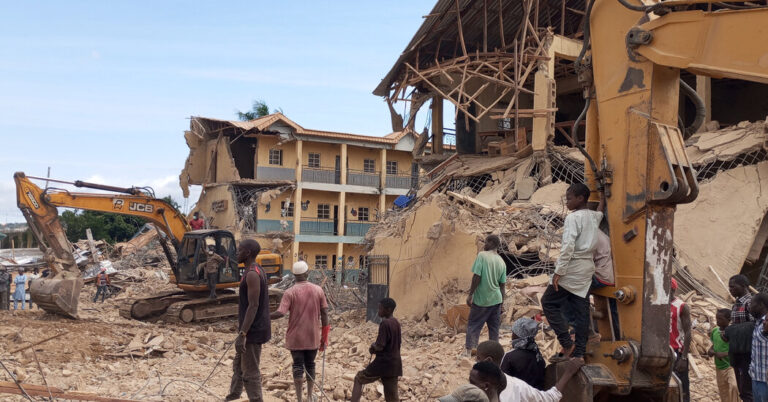Inside a private high school in Nigeria, Teiyei John was chatting with his classmates on Friday morning as they waited for the arrival of their Christian studies teacher, when a crack suddenly appeared in the wall of their classroom.
Seconds later, he said, the floor gave way under his feet and Mr. John was buried under the rubble of the three-story building at Saint Academy in the city of Jos, a regional capital.
At least 22 people died in the collapse, and 132 others were hospitalized, with victims still being counted on Friday night, according to local officials.
“I prayed to God, and thought my day had come,” Mr. John, 16, said in a telephone interview, shortly after he was discharged from the hospital with minor injuries on Friday evening.
Musa Ashoms, the top communications official for Plateau State, of which Jos is the capital, said in a statement that the victims included students and school staff. Emergency workers said that the death toll could rise.
“Casualty figures keep changing,” said Sunday Abdu, the executive secretary of the Plateau State Emergency Management Agency.
Buildings collapse relatively frequently in Nigeria, primarily because of the use of low-quality building material, poor or no soil testing before construction, and lax supervision and maintenance, according to building experts. Nigeria, Africa’s most populous nation, had the highest number of building collapses on the African continent, Farouk Salim, director general of the country’s public regulatory agency, acknowledged last year.
Throughout Friday, bystanders and rescue workers in Jos sifted through the rubble of the yellow school building that looked as though it had been sheared in half, leaving one part standing and the other, with a large corrugated iron roof, collapsed on the ground.
Mr. John, the student, said his school day had begun like any other: He had arrived at 6 a.m. for the morning assembly. Around 9:00, he was in his seat on the second floor of the school’s building when the crack appeared in the wall.
Then, there was shouting from all over the classroom, he said, and he felt himself falling — but not far, and he did not lose consciousness.
Mr. John said that he couldn’t move under the rubble, but that he had enough air to breathe and he called out to his classmates in the darkness. Some responded. Others didn’t.
Eyewitnesses, and relatives and friends of the students rushed to the school when they heard news of the collapse on Friday morning. One witness, Hosea Donald, 41, said that he and other bystanders had pulled out the bodies of eight students who had died in the collapse. Poorly maintained roads made it hard for ambulances to reach the site, he said.
Mr. John estimated that he was trapped under the rubble for about an hour, his chest thumping with pain, until he was rescued.
The cause of the building collapse was not yet clear. But harsh weather often undermines fragile infrastructure in Nigeria, experts say, and heavy rains had pounded Jos over the last few days, with more thunderstorms and downpours expected in the coming week.
More than 220 buildings were reported to have collapsed in Nigeria over the last four decades, according to the country’s public regulatory agency.
But the real number may be far higher.
The Building Collapse Prevention Guild, an advocacy group promoting safer construction practices in Nigeria, said in a report released this month that more than 600 buildings had collapsed in four decades. As of the first week in July, 22 buildings already had given way this year, the guild said.
Mr. John said he was back at home on Friday evening after undergoing X-ray exams. That he and most of his classmates were alive was a miracle, he said.
But, he added after a heavy silence, one of the students he was seated with a few hours earlier had died.



